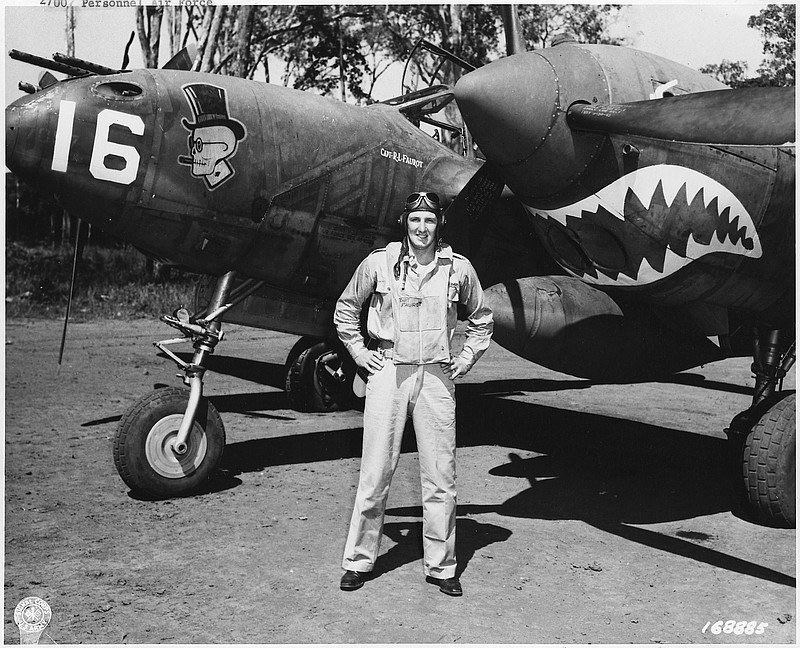Born in 1917 and later attending school in the Missouri communities of Mountain Grove and Chillicothe, a 6-foot-tall, strapping young Robert L. Faurot made the decision to attend the University of Missouri.
During the late 1930s, he established himself as a star halfback in the university's football program under the guidance of his brother, legendary college head coach Don Faurot.
Robert played as part of the Big Six Conference team in the Orange Bowl on Jan. 1, 1940. A few weeks later, with war on the horizon, he left college during his senior year to volunteer to train as an aviator. This decision would result in a shocking sacrifice that later inspired his older brother to enlist.
Faurot completed his primary flight training at Tulsa, Oklahoma, and underwent his basic aviation training at Randolph Field, Texas, in the weeks after his enlistment.
He and his fellow Air Corps cadets learned to pilot their 450-horsepower training airplanes under the guidance of seasoned instructor pilots, which included an introduction to night flying. In early September 1940, he qualified to transfer to Advanced Flying School.
"Robert L. Faurot is now a lieutenant in the United States Army Reserve Air Corps according to announcements reaching his friends in Chillicothe this week," reported the Chillicothe Constitution-Tribune on Nov. 16, 1940.
"Lieut. Faurot received his commission yesterday in graduation exercises held at Kelly Field, San Antonio, Texas," he newspaper added. "He has completed the course of training for the Army pilots and has taken his place in the reserves."
The young aviator was assigned to the 39th Pursuit Squadron of the 31st Pursuit Group at Selfridge Field, Michigan. While there, he was among a small group of pilots selected to travel to England and fly as observers with the Royal Air Force during the Battle of Britain, gaining flight experience in fighter planes, such as the Supermarine Spitfire and Hawker Hurricane.
"Returning to the U.S. and back again with the 39th Pursuit Squadron, (Faurot) flew many hours in the new P-39 Bell Airacobra during the military maneuvers held (during the summer and fall of 1941) in the southeastern U.S.," explained the website of the 39th Fighter Squadron Association.
Briefly assigned to Baer Field at Fort Wayne, Indiana, the association's website noted that following the attack on Pearl Harbor (Dec. 7, 1941), Faurot and the crews of the 39th Fighter Squadron received orders to report to the West Coast. From there, they transferred to Australia to prepare to enter the war.
Records reveal that Faurot was soon flying the Lockheed P-38 Lightning-a single-seat American fighter with distinctive twin tails. By June 1942, he and his fellow airmen were engaged in combat with Japanese aircraft.
The Kansas City Times reported of Faurot on Jan. 13, 1943, "For several weeks he has been in action on the New Guinea front, where he is deputy commander of his squadron. He became an ace in his first fourteen days of action there "
"Lieutenant Robert Faurot was credited with a bizarre kill of a Zero fighter at Lae Aerodrome in New Guinea," wrote Martin Caidin in his book "Fork-Tailed Devil: The P-38." He added, "As far as we know, it turned out to be the first Zero kill made by the P-38; and my logs and diaries indicated the date was November 26, 1942."
Sadly, the 25-year-old ace pilot from Missouri was killed on March 23, 1943, during the Battle of the Bismarck Sea after engaging Japanese Zeroes. The enemy aircraft were strafing U.S. airmen parachuting from a B-17 bomber that had just been shot from the sky.
Faurot and two of his fellow P-38 pilots embraced the element of surprise when shooting down the Zeroes that attacked their comrades, but subsequently revealed their presence to a larger group of Zeroes in the area. They were quickly overwhelmed and shot down; Faurot's aircraft crashed into the Bismarck Sea off the coast of New Guinea, and his remains were not recovered.
Initially, the pilot was considered missing in action, but it was eventually determined he was either killed in the attack or died because he was wounded and unable to escape his sinking aircraft. Capt. Faurot was posthumously promoted to the rank of major in January 1944.
During a ceremony held at Harris Field in Cape Girardeau (an area used as a training site for military pilots in World War II) on Feb. 5, 1944, Faurot's parents were presented with his awards, including the Distinguished Flying Cross, Silver Star with Oak Leaf Cluster, Air Medal and Purple Heart.
His loss inspired his older brother, Don Faurot, to temporarily abandon his position as head coach at MU to enlist in the U.S. Navy. Eventually, all three of Robert Faurot's brothers would serve in the military during the war. His family's legacy of service aside, the young aviator did not live to witness yet another honor bestowed upon him.
Robert Faurot's close friend and fellow pilot, Maj. Horace S. Carswell Jr., was killed in action Oct. 26, 1944, while participating in a bombing run in China aboard a B-24 bomber. Months earlier, while mourning the loss of Capt. Faurot, Carswell sought to ensure the memory of his departed friend would not be erased from history.
"Robert Ede, the son, was born while Major Carswell was stationed at Clovis Army Airfield," reported the Forth Worth Star-Telegram on Nov. 24, 1944. "He was named for Carswell's closest friend, Capt. Robert Faurot fighter pilot who was shot down in the Battle of Bismarck."
Jeremy P. Amick writes on behalf of the Silver Star Families of America.


